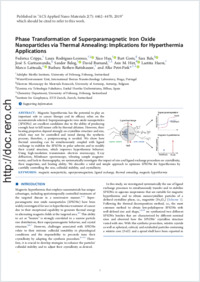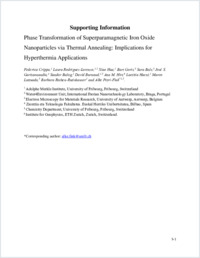Phase transformation of superparamagnetic iron oxide nanoparticles via thermal annealing: implications for hyperthermia applications
- Crippa, Federica Adolphe Merkle Institute, University of Fribourg, Switzerland
- Rodriguez-Lorenzo, Laura Adolphe Merkle Institute, University of Fribourg, Switzerland - Water4Environment Unit, International Iberian Nanotechnology Laboratory, Braga, Portugal
- Hua, Xiao Adolphe Merkle Institute, University of Fribourg, Switzerland
- Goris, Bart Electron Microscopy for Materials Research, University of Antwerp, Belgium
- Bals, Sara Electron Microscopy for Materials Research, University of Antwerp, Belgium
- Garitaonandia, José S. Zientzia eta Teknologia Fakultatea. Euskal Herriko Unibertsitatea, Bilbao, Spain
- Balog, Sandor Adolphe Merkle Institute, University of Fribourg, Switzerland
- Burnand, David Adolphe Merkle Institute, University of Fribourg, Switzerland - Chemistry Department, University of Fribourg, Switzerland
- Hirt, Ann M. Institute for Geophysics, ETH Zurich, Switzerland
- Haeni, Laetitia Adolphe Merkle Institute, University of Fribourg, Switzerland
- Lattuada, Marco Chemistry Department, University of Fribourg, Switzerland
- Rothen-Rutishauser, Barbara Adolphe Merkle Institute, University of Fribourg, Switzerland
- Petri-Fink, Alke Adolphe Merkle Institute, University of Fribourg, Switzerland - Chemistry Department, University of Fribourg, Switzerland
-
26.07.2019
Published in:
- ACS Applied Nano Materials. - 2019, vol. 2, no. 7, p. 4462–4470
English
Magnetic hyperthermia has the potential to play an important role in cancer therapy and its efficacy relies on the nanomaterials selected. Superparamagnetic iron oxide nanoparticles (SPIONs) are excellent candidates due to the ability of producing enough heat to kill tumor cells by thermal ablation. However, their heating properties depend strongly on crystalline structure and size, which may not be controlled and tuned during the synthetic process; therefore, a postprocessing is needed. We show how thermal annealing can be simultaneously coupled with ligand exchange to stabilize the SPIONs in polar solvents and to modify their crystal structure, which improves hyperthermia behavior. Using high-resolution transmission electron microscopy, X-ray diffraction, Mössbauer spectroscopy, vibrating sample magnetometry, and lock-in thermography, we systematically investigate the impact of size and ligand exchange procedure on crystallinity, their magnetism, and heating ability. We describe a valid and simple approach to optimize SPIONs for hyperthermia by carefully controlling the size, colloidal stability, and crystallinity.
- Faculty
- Faculté des sciences et de médecine
- Department
- Département de Chimie, AMI - Bio-Nanomatériaux
- Language
-
- English
- Classification
- Chemistry
- License
-
License undefined
- Identifiers
-
- RERO DOC 326959
- DOI 10.1021/acsanm.9b00823
- Persistent URL
- https://folia.unifr.ch/unifr/documents/308110
Other files
Statistics
Document views: 146
File downloads:
- pdf: 341
- Supplementary material: 208

